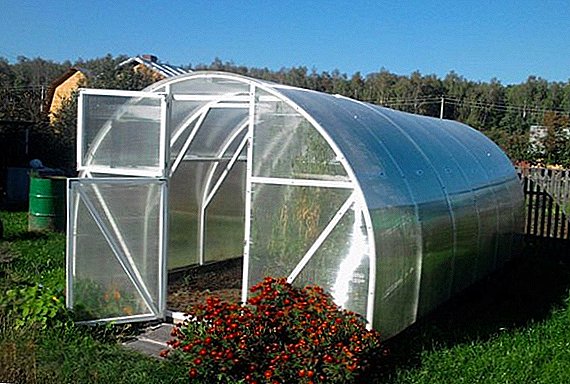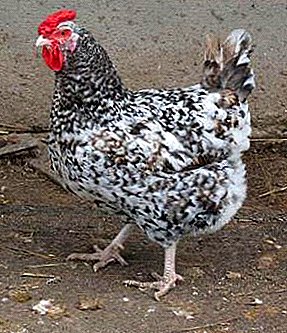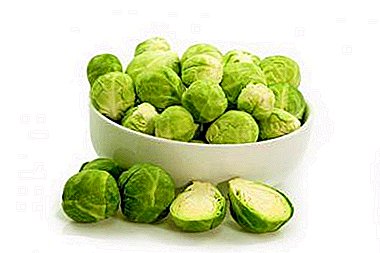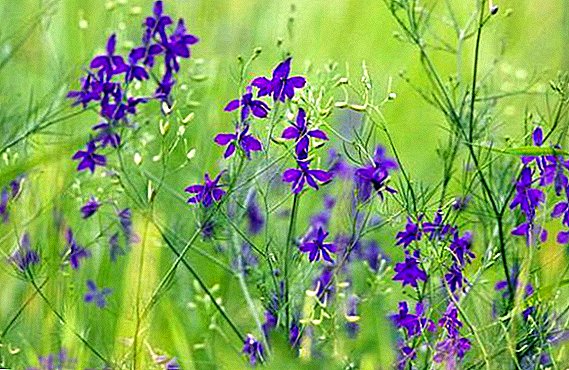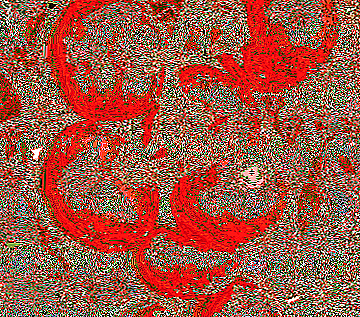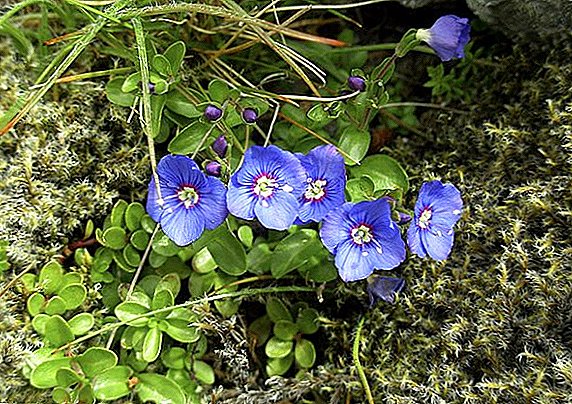 Veronica has a reputation as one of the oldest medicinal plants. Even in the Middle Ages, it was used to treat various diseases, but the recognition of its decorative qualities came much later. Veronica includes species that belong to the genus Veronikastrum and Veronichnik, but their appearance, care, and other points are almost identical, so it makes sense to consider them in one article.
Veronica has a reputation as one of the oldest medicinal plants. Even in the Middle Ages, it was used to treat various diseases, but the recognition of its decorative qualities came much later. Veronica includes species that belong to the genus Veronikastrum and Veronichnik, but their appearance, care, and other points are almost identical, so it makes sense to consider them in one article.
Did you know? Some grow Veronica as an alternative to lawn - it is very pleasant to walk barefoot on thick green mats, and most species have a high resistance to trampling.
Now, thanks to breeders, this species has many varieties that differ in size, shape and color of flowers. Veronica in its wild form has a very wide geography, but they are all great for growing in the garden. Next, consider the most popular species of this flower.
Veronica officinalis
Origin: Asia Minor, Caucasus.
Flowering time: June - September
Creeping stems of this species form a thick carpet up to 8-10 cm in height. The leaves have fluff on both sides, ovate, up to 3 cm in length. Veronica officinalis in the wild grows in forest glades and in the forests themselves. The annual growth of numerous stems can reach 20 cm.  This species is valued for resistance to trampling and prolonged droughts. Flowers are in dense, but at the same time small brushes which are located in the top part of stalks. The corolla has a diameter of only 6-7 cm, so veronica is grown as a decorative leafy plant. Poor soils are suitable for planting, just keep in mind that this plant, like many other types of Veronica, grows rapidly and is very competitive, that is, it is able to survive other crops.
This species is valued for resistance to trampling and prolonged droughts. Flowers are in dense, but at the same time small brushes which are located in the top part of stalks. The corolla has a diameter of only 6-7 cm, so veronica is grown as a decorative leafy plant. Poor soils are suitable for planting, just keep in mind that this plant, like many other types of Veronica, grows rapidly and is very competitive, that is, it is able to survive other crops.
Austrian Veronica
Origin: Europe, the Caucasus.
Flowering time: May - July.
Austrian Veronica is a plant 40-60 cm tall. It has a cord-like rhizome and erect stems, which are arranged singly or in groups. The leaves are arranged oppositely, pinnately dissected or pinnately-separated forms, narrowed at the base. Also, the plant is covered with a sparse fluff, but the flowers of Veronica Austrian are most attractive. Flowers are collected in single or paired brushes, 2-4 pieces each. They have a very beautiful bright blue color and reach 1 cm in diameter. 
Veronica Armenian
Origin: Asia Minor.
Flowering time: June July.
This species belongs to a tree-rhizomatous perennial plant that forms a thickened turf. Armenian Veronica has lying or ascending stems, lumbering from the base, the height of which reaches 5-10 cm. A large number of stems form, have very short pubescence, because of which their surface appears rough. The original strongly dissected feathery leaves resemble small needles up to 1 cm long. The racemes of the flowers are found on the shortened peduncles in the axils of the upper leaves. The corolla of pale lilac or dull blue color has a fragrant aroma. 
Did you know? Armenian Veronica is the most unpretentious kind, for which it is especially in demand among gardeners.
Armenian Veronica is very drought-resistant and frost-resistant.
Veronica is big
Origin: Western Europe, the Caucasus, the Mediterranean, Central Asia.
Flowering time: June.
This type of Veronica has a fairly wide geography, it can be found in rare forests, meadows or forest glades. Rhizomes are creeping, cord-shaped, and the stems are most often solitary, sometimes arranged in 2-3. They reach a height of 40-70 cm, thick, curly-haired. The leaves are ovate, sessile, arranged oppositely. From above, they can have single hairs, but most often are bare, and from the bottom, curly-hairy.  The flowers are located on the long racemes formed in the axils of the upper leaves, 2-4 pieces each. At the end of flowering shoots lie in different directions in such a way that the flowers are outside, around the bush, forming a kind of wreath. The flowers are usually blue, but there are other varieties where the flowers are blue or even white. Veronika large is very resistant to frost and drought, although it belongs to moisture-loving plants.
The flowers are located on the long racemes formed in the axils of the upper leaves, 2-4 pieces each. At the end of flowering shoots lie in different directions in such a way that the flowers are outside, around the bush, forming a kind of wreath. The flowers are usually blue, but there are other varieties where the flowers are blue or even white. Veronika large is very resistant to frost and drought, although it belongs to moisture-loving plants.
Veronica branchy
Origin: Europe (mountain regions).
Flowering time: June.
This type of Veronica is slow growing. It has a high decorative value, but it requires careful maintenance. It grows in the form of cushion thickets of average height (5-10 cm). Stems woody at the base, covered with leathery leaves. Long pedicels adorn bright-blue flowers collected in a brush, with a reddish belt at the base of the calyx. There are pink flowers, but it is considered a rarity.
Important! Although the genus Veronica is considered to be frost-resistant, the Veronica branching requires shelter with lapnik branches for the winter.
This species is best suited for planting near rocky hills. Does not tolerate overheating, so it is best to land in partial shade.
Veronika woody
Origin: Asia Minor.
Flowering time: May - July.
This perennial plant is ideal for stony hills. Stems of this species have a high creep, as well as the leaves, they are covered with gray pubescence. Stems are numerous, and the leaves grow densely, as a result forming a stunning gray-green carpet 4-5 cm tall. During the flowering period, this carpet is decorated with small pink flowers. 
Important! In snowless winters Veronika ligneous can freeze, therefore it is recommended to cover it with pine spruce branches.
For optimal growth, it is desirable to plant in loose sandy soils with good drainage. Well suited dry sunny places.
Veronica dlinnolistnaya
Origin: Europe, Central Asia.
Flowering time: July-September.
The tall stems of this plant can reach 1.5 m in height. The leaves, thanks to which this Veronica got its name, are arranged in 3-4 pieces of flour or opposite, in width can be from 1 to 4 cm, and in length - 4-15 cm. The flowers are small, depending on the variety can have pink, white, gentle or bright blue color. The inflorescences are located on the tops of the stems, reach a length of 25 cm, most often branching. 
Did you know? One plant can have up to 450 flowers.
Veronika Dubravnaya
Origin: Europe, the Caucasus, Western Siberia.
Flowering time: The end of May is June.
In nature, this plant can be found in the fields and forest edges. This plant has a thin creeping rhizome, can reach a height of 40 cm. The stems are ascending, in the internodes have 2 rows of long hairs. The leaves also have a down, sessile, located opposite, on the edge there are large teeth. Loose brush located in the axils of the upper leaves.
Compared with the size of the plant, the flowers of the oak tree Veronica are rather large, up to 15 mm in diameter, blue or bright blue in color, with dark veins. Sometimes you can meet this species with pink flowers. As they grow, shoots begin to lean toward the ground. In this place, adventitious roots begin to form, and the tops of the stems further grow vertically.
Caucasian Veronica
Origin: Caucasus.
Flowering time: end of May-June.
 Like many other species, the Veronica Caucasian is a reliable ornamental plant, unpretentious in care and resistant to any vagaries of the weather. It has some similarities with the Armenian Veronica, but the flowers of the latter are blue, while the flowers of Caucasian Veronica are painted in blue tones. Stems ascending or straight. Leaves sessile, oblong or ovate, strongly pinnately dissected. The brushes are located opposite the upper sinuses of the leaves.
Like many other species, the Veronica Caucasian is a reliable ornamental plant, unpretentious in care and resistant to any vagaries of the weather. It has some similarities with the Armenian Veronica, but the flowers of the latter are blue, while the flowers of Caucasian Veronica are painted in blue tones. Stems ascending or straight. Leaves sessile, oblong or ovate, strongly pinnately dissected. The brushes are located opposite the upper sinuses of the leaves.
Caucasian Veronica is one of the leaders in frost resistance and drought resistance, therefore it is not worth worrying about shelters and choosing special places for growing.
Veronika spiky
Origin: Europe, the Caucasus, the Mediterranean.
Flowering time: July August.
Spike Veronica has few or no single stems, up to 40 cm high. Upper leaves sessile, and lower ones are petilate, ovate or oblong. Inflorescences are formed on the tops in the form of thick brushes, can reach a length of 10 cm. The color of flowers can be purple, bright blue, pink or white. 
Important! This type of veronica bears fruit quite abundantly, therefore it can produce self-seeding
He loves loose garden soil, is able to endure winter without shelter. Drought tolerant and loves the sun, but too wet for her is not particularly scary. Modern varieties of this species can boast longer flowering and compact size of the bush.
Veronica filamentous
Origin: Europe.
Flowering time: May June.
In nature, Veronica filamentous is most prevalent in the mountain meadows of Europe. Creeping stems in height barely reach 5 cm, and the stems, when in contact with the ground, take root, eventually turning into a large light green carpet. The leaves are rounded. Flowers are arranged singly on long legs, blue color with dark veins. To care, like other creeps, veronica threadlike is absolutely not demanding, but it is not at all because of this that one has to watch it. This species can very easily become a weed for your garden if its growth and distribution is not controlled.  Despite the high resistance, it freezes partially in the snowless winter, but at the same time it is quickly restored later. Ideal for creating carpet arrays, it can also be used for securing slopes and planting in terraced rockeries.
Despite the high resistance, it freezes partially in the snowless winter, but at the same time it is quickly restored later. Ideal for creating carpet arrays, it can also be used for securing slopes and planting in terraced rockeries.
Veronica creeping
Origin: Western Europe.
Flowering time: May June.
 Thin shoots of this type form a dense carpet, which quickly grows. The leaves are opposite, shiny, lanceolate or oval. The plant does not need additional feedings, all care for it consists in timely watering.
Thin shoots of this type form a dense carpet, which quickly grows. The leaves are opposite, shiny, lanceolate or oval. The plant does not need additional feedings, all care for it consists in timely watering.
Planting this type of Veronica near trees or shrubs can provide them with reliable protection from both frost and summer heat. Veronica creeping also resistant to trampling, so it is perfect as a lawn. The height of the shoots reaches a maximum of 15 cm, so you can do without mowing.
Important! Because of the strong creep and competitiveness, this Veronica can turn into a real weed, so you need to carefully monitor its growth.
Tiny flowers (3-4 mm in diameter) are formed in racemes 4-8 cm in length, the color can be pink, blue or white.
Veronica is small
Origin: Elbrus, Ermani Plateau, Kazbek.
Flowering time: July August.
This bush has a cushion shape, and its geography is rather peculiar, since it is associated with volcanic substrates, which makes it a local endemic and stenochor of these places. 
Did you know? A plant is a stenochorum if its seeds are spread only by animal organisms.
Veronica has small thin stems that adorn small opposite grassy leaves of elliptical or oblong shape. The core-type root system goes very deep into the ground. The flowers have a blue-blue color, and at the base of the corolla there is a white enlightenment.
Veronika is gray
Origin: Western Europe.
Flowering time: August.
This type of name was due to the whitewashing of the leaves and stems. Veronica gray in the process of growth forms a small sprawling bush, which can grow up to 40 cm in height. The leaves are broadly lanceolate, arranged oppositely. The flowers are blue in color, the inflorescences can reach 4-5 cm in length. Different varieties can vary slightly in plant height and leaf size, and the flowers can have different saturations, from bright blue to dark blue. It has good drought tolerance, calmly transfers winter without shelters. 
Veronica Schmidt
Origin: Japan, the Kuril Islands, Sakhalin.
Flowering time: May June.
Veronica Schmidt is a small compact bush, the shoots of which reach 20 cm. The underground part consists of fibrous roots and thin lignified rhizome. The leaves are pinnately separate, they are located mainly at the surface of the soil. This species is valued for large flowers up to 2 cm in diameter, which additionally adorn long stamens with bright yellow anthers. Flowers themselves may have a different color, depending on the variety.  Veronica is an unpretentious perennial culture, so it is perfect for those who want to minimize the costs of garden care, to enjoy their rest instead.
Veronica is an unpretentious perennial culture, so it is perfect for those who want to minimize the costs of garden care, to enjoy their rest instead.


